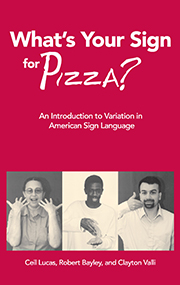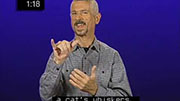An Introduction to Variation in American Sign Language
Ceil Lucas, Robert Bayley,
and Clayton Valli
Now in Paperback!
October 2003
|
View the table of contents. Read an excerpt. Read a review. View the supplemental video content online. |
$35.00s print edition $35.00 e-book |
From the Journal of Deaf Studies and Deaf Education
When William Stokoe first recognized American Sign Language (ASL) as a “real” language in the 1960s, it marked the beginning of analyzing who used the language and how. What’s Your Sign for Pizza? reports on a project called Sociolinguistic Variation in ASL. The goal “was to provide a representative sample of ASL as it is used across the United States” (p. 56).
The authors begin with a review of variation as it relates to spoken language, which gives a helpful frame of reference for the ASL variation discussion that follows. As with other languages, ASL changes over time and is influenced by users’ backgrounds and locations. With that sociolinguistic premise, variations that have evolved in ASL are observed and documented for this project. Seeing language “in the works,” the researchers had hoped to observe “natural” language use, despite the acknowledged fact that people knew they were being observed, which may or may not have altered sign choices.
The book includes a CD, which offers excellent examples of skilled native users of ASL. Segments are designed to interface with the book’s chapters; as a visual complement, the CD supports the information discussed in each related chapter. The viewer, however, needs to be fairly skilled in sign language to be able to notice the specific points and nuances that are referenced. Phonological, syntactic, and lexical variation are explained, with examples shown on the CD. The book is based on a long-term (1994–2001) research project that included over 207 deaf people, aged 15–55+ years, in seven regions of the United States. A good deal of variation was observed, with some social constraints similar to spoken languages: age, gender, region, and ethnicity. “Supplementary Readings” complete the book: These are three articles that lend support for the need to study variation in language, particularly ASL; lexical variation in African-American and white signing; and factors related to sociolinguistic variation.
Initially, the book includes a basic history of the origin of ASL, and although interesting, it would be assumed that the target audience for a book on sign variation already possesses this knowledge. There are study questions throughout the book that lead one to believe this book is designed for classroom instruction, but the intended audience is ambiguous. What sets this book apart is the research study that gathered representative examples of ASL, some of which are shared on the CD. However, as noted, only people with fairly strong ASL receptive skills can appreciate the CD.
Considering all that the book has to offer, What’s Your Sign for Pizza? would be meaningful for those in the field of interpreting and interpreter education, ASL instructors, and other individuals who have a desire to deepen their understanding of variation and its influence on the evolution of ASL. Readers will gain insight into what constitutes variation, the different types, and potential reasons for why and how variation has developed over the years. Above all, this book gives strong justification for the importance of further research into the area of sociolinguistic variation in ASL.
Ceil Lucas is Professor Emerita of Linguistics at Gallaudet University.
Robert Bayley is a professor in the Department of Linguistics at the University of California, Davis.
Clayton Valli was an assistant professor in the Masters Interpreting Program at Gallaudet University.
Print Edition: ISBN 978-1-56368-572-9, 6 x 9 paperback, 200 pages, 5 tables, 18 figures
$35.00s
E-Book: ISBN 978-1-56368-299-5
$35.00
To order by mail, print our Order Form or call:TEL 1-800-621-2736; (773) 568-1550 8 am - 5 pm CST
TTY 1-888-630-9347
FAX 1-800-621-8476; (773) 660-2235

